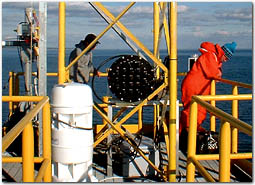
|
 |
Science Highlights > Exploring the Boundary of Sea and Sky
Exploring the Boundary of Sea and Sky
 |

Click to enlarge
|
|
Jay Sisson, left, and Mike Purcell complete connection of the Martha’s Vineyard Coastal Observatory Air-Sea Interaction Tower data node (black cylinder at center) with the observatory laboratory ashore. The connection facilitates transmission of a variety of data from tower sensors both above and below the sea surface. The south shore of Martha’s Vineyard is in the background. (Photo by Jim Edson) |
The complex processes at work where the sea meets the sky is the topic of a major Office of Naval Research-sponsored effort involving eight WHOI investigators. During the 2001 and 2002 field seasons, they collected data using moorings and floats and built the Air-Sea Interaction Tower (ASIT) at the Martha’s Vineyard Coastal Observatory. The ASIT will be an important enhancement for the 2003 field season.
The program, called CBLAST for Coupled Boundary Layers and Air-Sea Transfer, is designed to improve understanding of ocean-atmosphere interactions in low to moderate winds and to improve marine weather forecasts and ocean circulation models. To accomplish these goals, researchers are measuring vertical exchange of momentum, heat, and mass at the air-sea boundary; identifying processes that drive this exchange; and creating a 3-D map of the boundary layers over a range of space and time scales.
Six moorings with surface buoys were deployed south of Martha’s Vineyard in June 2002. Their objective was to capture data from both atmosphere and ocean for studies of how ocean currents, temperature, and salinity respond to momentum from the wind and energy from the sun. The mooring data will help improve atmospheric and circulation models being developed at WHOI and elsewhere.
Located 3.2 kilometers (2 miles) offshore and connected by cable to the observatory, the ASIT supports instruments that can directly measure momentum and heat exchange on both sides of the air-sea interface. This unique coastal-processes platform will contribute to investigations that include air-sea interactions, ocean mixing, biological content of the water, and sediment transport.
|
|
